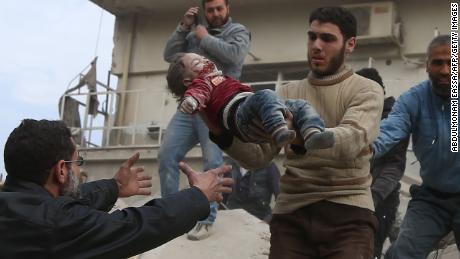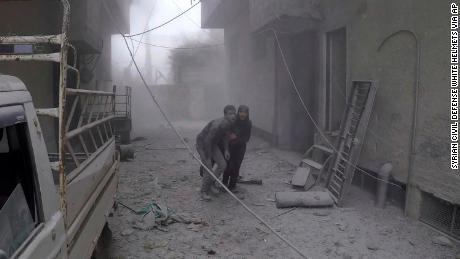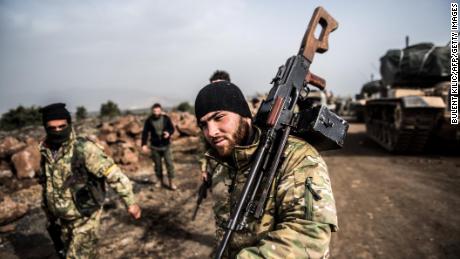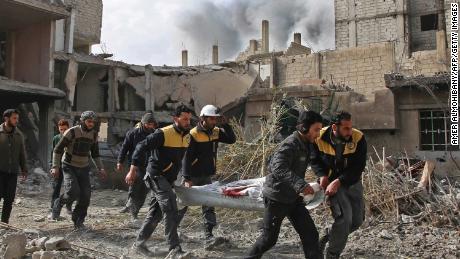People in Eastern Ghouta endure 4 days of shelling by Syrian forces

Dust-covered survivors come stumbling from the rubble and twisted metal of another bombardment. Some clutch injured children in their arms, desperate for help. Faces are contorted with suffering or numb with shock.Harrowing images from Eastern Ghouta, a besieged rebel-held area east of Syria's capital, show the horror of four days of intense bombardment this week by what observers say are Russian-backed Syrian forces.At least 229 people were killed from Monday to Thursday, according to the Syrian Observatory for Human Rights monitoring group. Among the dead were 58 children and 43 women, the UK-based group said.The four days of airstrikes and shelling also have left at least 700 civilians injured, according to the group.The White Helmets volunteer search and rescue group had different figures. A spokesman said 80 people died Thursday alone in Eastern Ghouta. Since the start of the month, the group has documented 234 deaths there, including 66 children and 42 women.The Union of Medical Care and Relief Organizations, a medical group operating in Syria, put the toll even higher, saying 237 civilians had been killed and 1,250 injured over the four days of strikes in Eastern Ghouta.Three medical facilities and a dental clinic were damaged in attacks Tuesday and Wednesday, which also caused casualties, the group said in a statement. "Our hospitals and medical facilities are being hit by surgical strikes. The injured have nowhere to turn and are dying in the streets and their homes," said the group's chairman, Dr. Ghanem Tayara. Abdullah al-Hafi, 35, a civilian in Eastern Ghouta, told CNN on Friday that the past four days had been the most intense since 2015, with more than 260 airstrikes and a large number of deaths.He said he tried to help after witnessing an airstrike Thursday in the town of Hamurriya. "I was trying to help with saving the injured people," he said. "I saw three kids who died there. The area that was struck is the most poor area in Hamurriya."Another airstrike hit the nearby town of Saqba on Thursday evening, he said. "Thankfully no one was killed and some were injured, minor injuries, but the problem was that 10 families lost their houses in that airstrike, and I saw them trying to find a shelter to sleep in."Eastern Ghouta, a suburban area near Damascus, has been surrounded by Syrian forces for more than four years. The siege intensified in May when government forces conducted a large-scale offensive. According to the United Nations, nearly 400,000 civilians are trapped in the area, with half thought to be children. President Bashar al-Assad's regime has recently ramped up attacks against the opposition, with US officials accusing his forces of using chemical weapons such as chlorine in recent weeks in Eastern Ghouta and Idlib, another rebel stronghold.Eastern Ghouta, which is controlled by various Islamic rebel groups, was supposed to be a "de-escalation zone," according to a peace agreement struck by Russia, Turkey and Iran in May.But images of devastation emerging from the area are reminiscent of the height of the siege of Aleppo more than a year ago. They are also a graphic reminder that although ISIS' stranglehold on parts of Syria has been broken, multiple conflicts involving multiple players remain.The United Nations called this week for an immediate monthlong ceasefire in Syria as the humanitarian situation worsens.
President Bashar al-Assad's regime has recently ramped up attacks against the opposition, with US officials accusing his forces of using chemical weapons such as chlorine in recent weeks in Eastern Ghouta and Idlib, another rebel stronghold.Eastern Ghouta, which is controlled by various Islamic rebel groups, was supposed to be a "de-escalation zone," according to a peace agreement struck by Russia, Turkey and Iran in May.But images of devastation emerging from the area are reminiscent of the height of the siege of Aleppo more than a year ago. They are also a graphic reminder that although ISIS' stranglehold on parts of Syria has been broken, multiple conflicts involving multiple players remain.The United Nations called this week for an immediate monthlong ceasefire in Syria as the humanitarian situation worsens.
Food, medicine lacking
Syrian activists report rapidly deteriorating conditions — the worst in four years — in Eastern Ghouta, with hundreds of thousands of residents struggling from shortages of food and medical supplies. The UN children's agency UNICEF warned Thursday that dozens of children had reportedly been killed this week by "extreme and intensifying violence" in parts of Syria and called for an immediate halt to hostilities. "In East Ghouta alone, hundreds of children are in urgent need of medical evacuation," said UNICEF Executive Director Henrietta Fore. "Four years of siege have crumbled health and other basic services critical to children's survival and growth. Over the past few months, malnutrition has increased five-fold. "For children who remain trapped under siege and under wanton, heavy violence across Syria, life is a living nightmare. They are struggling just to stay alive."UNICEF reported in late November that nearly 12% of children under 5 in Eastern Ghouta were suffering acute malnutrition.
The UN children's agency UNICEF warned Thursday that dozens of children had reportedly been killed this week by "extreme and intensifying violence" in parts of Syria and called for an immediate halt to hostilities. "In East Ghouta alone, hundreds of children are in urgent need of medical evacuation," said UNICEF Executive Director Henrietta Fore. "Four years of siege have crumbled health and other basic services critical to children's survival and growth. Over the past few months, malnutrition has increased five-fold. "For children who remain trapped under siege and under wanton, heavy violence across Syria, life is a living nightmare. They are struggling just to stay alive."UNICEF reported in late November that nearly 12% of children under 5 in Eastern Ghouta were suffering acute malnutrition.
Underground shelters
As the bombardment intensified this week, aid group Save the Children warned Thursday that tens of thousands of children were in immediate danger, with more than 4,000 families trapped in underground shelters by the bombing.Partners on the ground report that 45 schools in Eastern Ghouta have been attacked and 11 of those destroyed, Save the Children said. Much-needed aid is blocked from entering the area, and civilians, including critically ill children, are barred from leaving, it said.With food scarce and prohibitively expensive, most families are trying to survive on one meal a day, the aid group said. US State Department spokeswoman Heather Nauert raised the alarm Thursday over the "escalating violence in Idlib, the Damascus suburbs of Eastern Ghouta, and other areas of Syria threatened by ongoing regime and Russian airstrikes."The United States backs the UN call for a humanitarian ceasefire, she said."We are yet again appalled by the recent reports of the Assad regime's use of chemical weapons and the escalation of bombings that has resulted in dozens of civilian deaths in the last 48 hours, as well as the continued abhorrent attacks on civilian infrastructure, including hospitals, which resulted in increased displacement. These attacks must end now."
US State Department spokeswoman Heather Nauert raised the alarm Thursday over the "escalating violence in Idlib, the Damascus suburbs of Eastern Ghouta, and other areas of Syria threatened by ongoing regime and Russian airstrikes."The United States backs the UN call for a humanitarian ceasefire, she said."We are yet again appalled by the recent reports of the Assad regime's use of chemical weapons and the escalation of bombings that has resulted in dozens of civilian deaths in the last 48 hours, as well as the continued abhorrent attacks on civilian infrastructure, including hospitals, which resulted in increased displacement. These attacks must end now."
CNN's Mohammed Tawfeeq, Eyad Kourdi, Hamdi Alkhshali and Michael Callahan contributed to this report.
Original Article
[contf] [contfnew] 
CNN
[contfnewc] [contfnewc]




